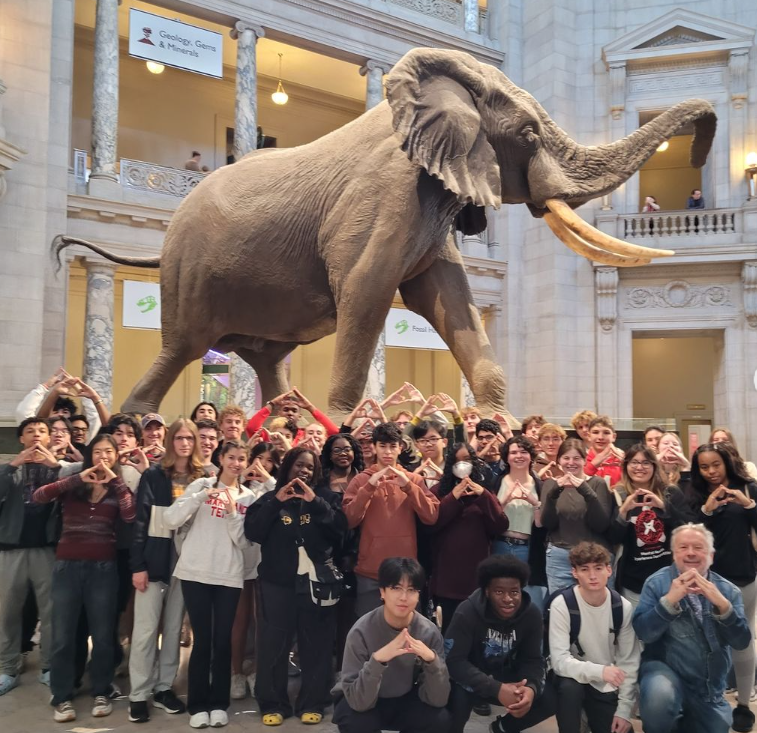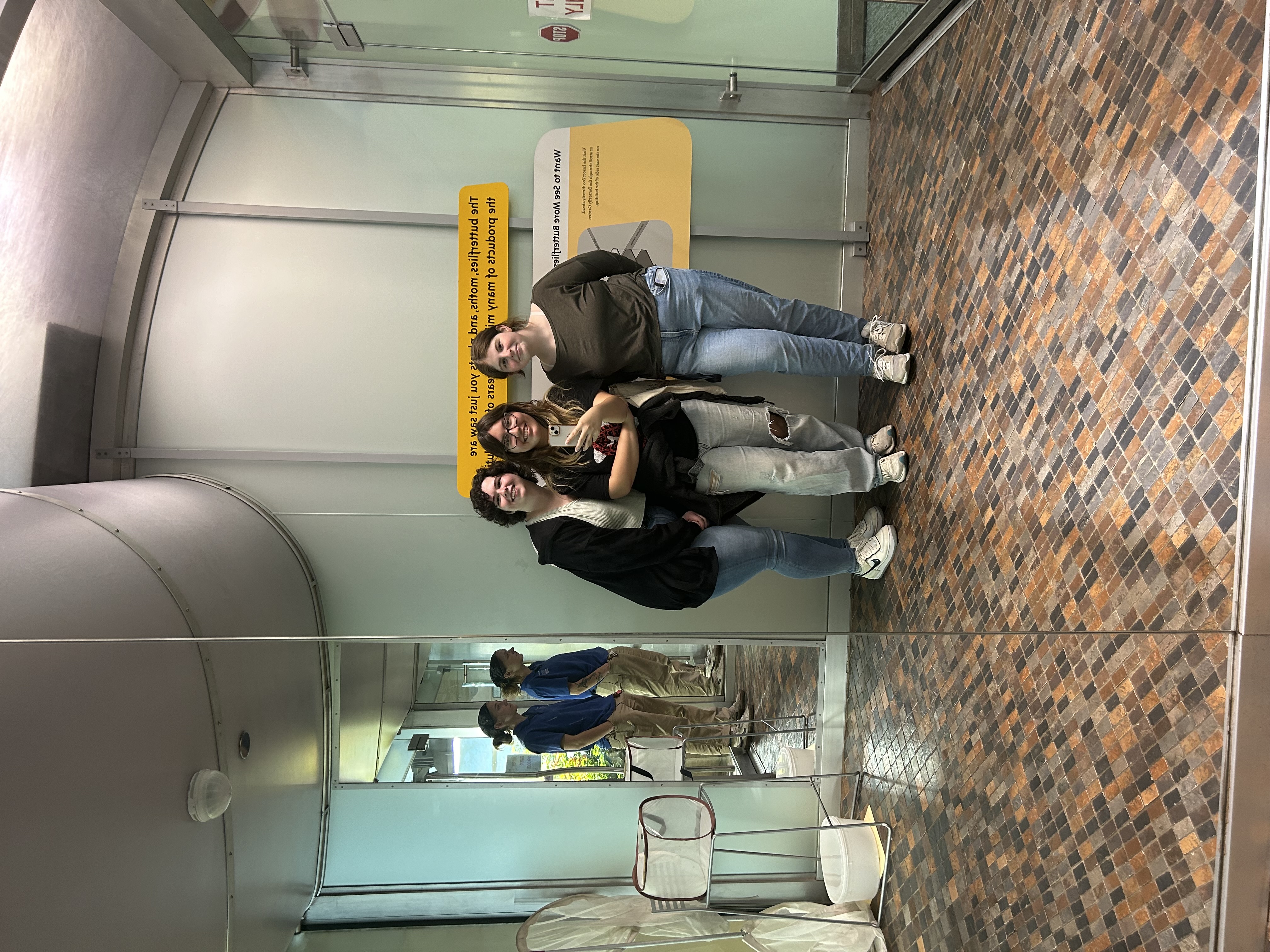Smithsonian Museum Trip
October 20th, 2024 at the Smithsonian National Museum of Natural History

Science and Global Change Scholars Group Photo!
After some time well-spent in the Butterfly Pavilion with Cat and Kellie, we all headed to the special exhibit “Cellphone: Unseen Connections” on the second floor. This exhibit contained a variety of techniques to inform guests about the impacts, influences, and materials that go into making and using cellphones on a daily basis. There were several ways to engage guests in this exhibit, including an interactive emoji generator, a QR code that led to a “group chat”, and more traditional displays, such as the design elements for each component of a phone. Beginning with the interactive emoji generator, I believe it is effective for attracting guests to this exhibit, however, it falls flat when it comes to providing the guests with memorable information. Despite this drawback, the emoji generator is the first portion of the exhibit visitors are greeted with making it particularly effective at enticing guests of all ages to explore the exhibit further. At the end of the emoji generator segments, guests are encouraged to scan a QR code that will “add them to the group chat” to learn more about cell phones. Kellie, Cat, and I all did scan the QR code although I expect most guests to ignore this action entirely. Furthermore, after exploring the website, the information presented was based on guest responses to survey questions. For example, one question asked guests about how many hours they believe they use their phone a day; while this answer could be interesting, I received a response of “0% of other guests agree” to each of the possible answer choices. This may be due to the WiFi connection within the museum, but this experience was not as effective as one would expect. Luckily, not all of the exhibits I felt were uninformative, once past the introductory section of the exhibit more traditional displays could be seen. The most effective displays for my age demographic were more traditional visuals with descriptions on signs nearby, video displays, or even a timeline of the impacts phones have made in their history. It was much easier to remember and understand the information presented in this manner compared to the wall littered with comic strips, flashing lights, and interactive video games.
A significant message in this exhibit involved discussions of the environmental issues in the creation, use, and disposal of these cell phones. In terms of creation, one display presented approximately 65 elements that go into putting together cellphones; some of these materials such as lead, mercury, and beryllium are all hazardous chemicals to the environment and its wildlife. Similarly, these chemicals are difficult to properly dispose of without impacting the environment further, especially lithium which is used in phone batteries. The process of lithium brine extraction is known for draining drinking water supplies and leaching chemicals into areas where water is already scarce, such as Bolivia and Chile. Furthermore, mining of these elements, especially Tantalum, can take place in conflict-affected areas, where miners operate in dangerous conditions without protection from law. Information about both Tantalum and Lithium can be found on a shared panel within the “Raw Materials to Recycling” section of the exhibit which would eventually segway guests into societal and technological impacts of cellphones.

Kellie, Cat, and I heading out from the Butterfly Pavilion!
Past the materials portion of this exhibit, we reach the “Before and Because of Cellphones” timeline that outlines not only the social impacts but technological shifts seen from the introduction and use of cellphones. When it comes to the technology of cellphones, one specific impact involves the improvements to the capabilities of cellphones from simply a voice calling system to one that contained hundreds of functions from a wallet, newspaper, music player, map and so much more. Lining the first half of the timeline wall was over 80 items and their functions that have been condensed into a simple device that can fit into our pockets. More societal impacts of cellphone usage can be found further down the timeline, including the fundamental shift to the way people connect and communicate through the ability to create, edit, combine, and share experiences over social media, as well as the ease of conducting research, running businesses, and working from home.
Once we wrapped up our visit on the second floor, we made our way to our next exhibit on the first floor in the David H. Koch Hall of Human Origins specifically in the “Humans Change the World” section. After passing through the “Time Tunnel” and learning about the six major evolutionary milestones eventually rounding the corner to take a glimpse at some of the current impacts humans have and will continue worldwide. Three specific topics discussed throughout the exhibit include the impacts of how humans have evolved over time, specifically looking at skulls, the adaptation and importance of tool making, as well as the origins of modern humans. Beginning with human evolution, the museum presents this topic through a 1-minute video presentation and “touch fossil skulls” of extinct apes to see and feel the shared features between humans and apes, gorillas, and chimpanzees. The overarching themes of human milestones, specifically tools, were presented through sculptures and the act of walking through time as you moved further into the hall. In terms of human origins, this message was presented to guests at the end of their time in the David H. Koch hall in a 5-minute media presentation that is projected on a globe to emphasize inclusion and celebration of the human species journey around the world as all living humans today share 99.9% identical DNA.
There are some who criticize this section of the Hall on the grounds that it fails to emphasize issues such as human impact on the environment and climate, but I believe the hall's purpose is not to highlight these issues in particular. I believe that there are hundreds of other displays and entire portions of the museum that dive deep into these topics more appropriately, such as the limited time exhibit “Earth Information Center” that describes NASA's role in climate change. Although the critiques may not be entirely unjustified, I would argue that this section does mention mankind's impact on the environment through agriculture, diseases, and population, but not in as much detail as some would like.
After learning about our human history from ancient times to modern day, we headed to the Sant Ocean Hall right nearby to view a few videos in “The Changing Ocean” interactive video stations. After scrolling through all of the possible video topics, we landed on watching our first video titled “What is the Great Pacific Garbage Patch?” and “No Sunlight, No Problem.” The Great Garbage Patch video describes that garbage patches are large areas of marine debris concentrations that are rotated in ocean currents called “gyres”. Further, the video explores how difficult it is to clean a garbage patch due to its sheer size and depth, the disruption of wildlife caused by cleaning efforts, and our greatest asset being prevention. Our second video covered the variety of animal species that live at the bottom of the sea floor in Hawai'i as well as the research behind discovering new species in this same area. The greatest hurdle for these videos is simply finding and selecting the video to watch as the content for each video we watched had concepts described in an understandable manner and supporting images/graphics. General visitors are likely to miss this opportunity completely, especially on a busy museum day, since only a few people could view the video at a time, not to mention if the console ever had technical problems.
After viewing our two short form videos, we headed into the “Science on the Sphere” theater which provided a selection of benches to sit on before the show began. Throughout one entire show, a variety of topics were discussed including Pangea, tectonic plates and their movements, water and wave patterns and many more similar topics. The sphere as a method of viewing I thought was quite interesting allowing guests to view different portions of the globe throughout the entire presentation. The dissections of the earth's layers, movement of tectonic plates, and the passage of time through sea level rise significantly benefited from this viewing format. However, I found a major downside to this format was the pacing and distinction between topics as we struggled to figure out when the entire presentation was completed or if topics were simply mentioned again, finding the presentation somewhat repetitive. Other guests had a similar opinion as most people that began the show with us either had already left or even fallen asleep!
Soon we passed through David H. Koch Hall of Fossils section that highlights ancient ecosystems, the evolution of life, and provides viewing of over 700 fossil specimens specifically looking for the paleoenvironmental dioramas. The first pylon we investigated was titled “Lush Rainforests” which represents a dense rainforest once residing in Willwood Formation, Wyoming between 56-53 million years ago. In this period, CO2 levels were five times higher than they are today, the average global temperature was 14-25 degrees Fahrenheit warmer, and sea levels were 720 feet higher. Our second pylon was labeled “Grasslands Far and Wide” which represented a lush plain in the area of Harrison Formation, Nebraska around 24-16 million years ago. Compared to our first diorama, the CO2 levels were twice as great compared to current CO2 levels, the average global temperature 5-12 degrees Fahrenheit warmer, and sea levels were 330 feet higher than today. With intricate dioramas and panels of information with simple graphics showing changes in CO2 levels, global temperatures, and sea levels, and more details below these icons, the dioramas are fascinating and the longer you look, the more intriguing guests you find.
The last major section of the Koch Hall contained a section of kiosks describing climate change past and present throughout different time periods ranging from the Devonian to Cretaceous period. Beginning with the Devonian period, sea levels and CO2 levels were moderately high despite the extremely cold temperatures. Moving forward in the Permian period, the sea level, temperature range, and CO2 levels were far lower compared to those of today. One key note about this period is the end of the Paleozoic Ice Age. Cretaceous sea levels and temperatures were much higher than those of today, while CO2 levels were only moderately higher than they are today. Primarily this fossil and geological information was presented on screens accompanied with a user interface to click through important time periods. Despite this data playing a vital role in the understanding of current and future climate, the information is not presented in a manner that is easy to understand or relate to as well as being outweighed by the eye-catching skeletons right across the way from this display topic. Guests are not able to understand the importance of understanding what other time periods with more extreme CO2 levels, for example, look like compared to those of the present and how a society should take an active role in mitigating climate change.


